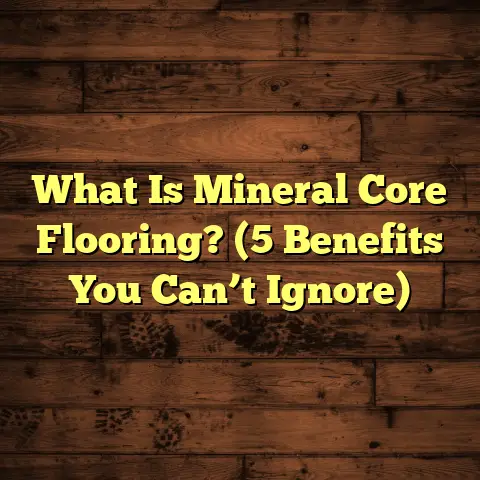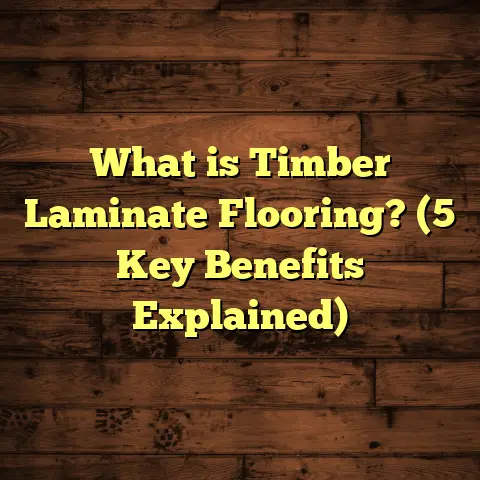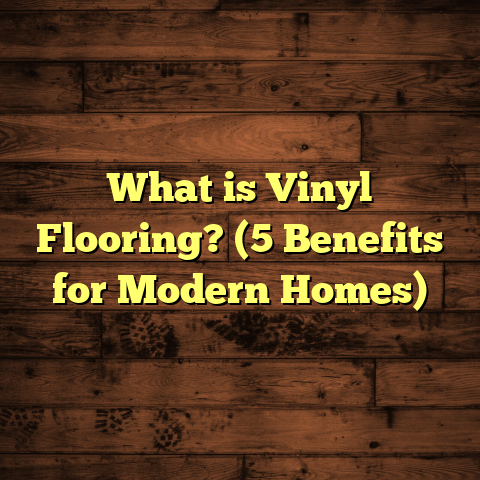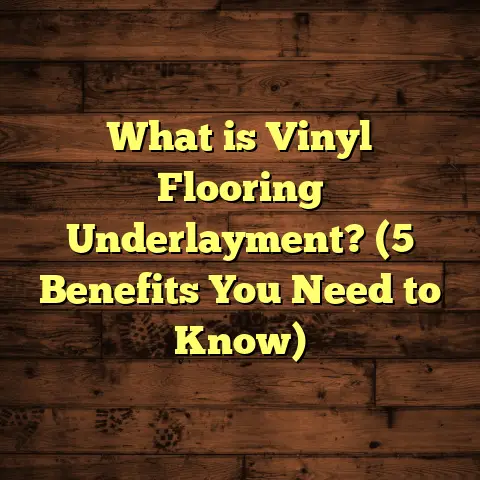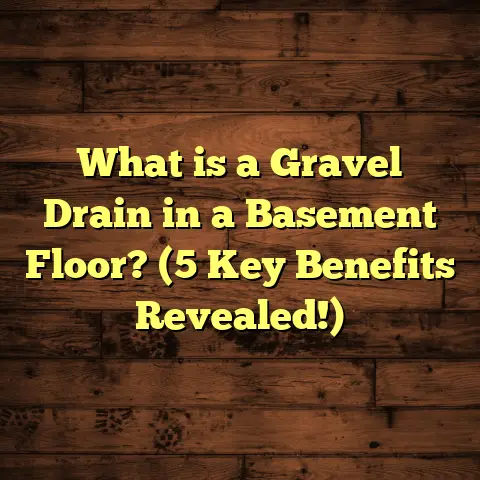What is Luxury Vinyl Plank Flooring Made Of? (5 Key Ingredients!)
According to the Flooring Industry Association, luxury vinyl plank flooring sales have surged by over 150% in the past five years alone. That’s a staggering number that speaks volumes about its popularity. If you’re like me and have spent years working closely with different flooring materials, you might wonder what makes luxury vinyl plank (LVP) so attractive. Well, the secret lies in what it’s made of — and understanding that gave me a whole new appreciation for this versatile flooring option.
What is Luxury Vinyl Plank Flooring?
Luxury vinyl plank flooring is a type of resilient flooring designed to replicate natural materials such as hardwood and stone. Unlike traditional vinyl sheets that come in large rolls, LVP is manufactured in individual planks, which makes it easier to install and creates a more authentic wood-like appearance.
I remember when I first started installing LVP, I was struck by how close it looked to real hardwood — even to the touch. The way the surface texture mimics wood grain and how the individual planks fit together make a big difference. But beyond appearances, LVP offers durability and adaptability that few other flooring types can match, especially in spaces prone to moisture or heavy traffic.
The magic behind LVP lies in its composition. Each plank is made up of multiple layers that work together to provide beauty, strength, and comfort. Let’s break down the five key ingredients that make up luxury vinyl plank flooring and why each one matters.
1. PVC Vinyl Core – The Heart of Luxury Vinyl Plank
At the center of every luxury vinyl plank is the PVC vinyl core. This is the thick plastic layer that gives the plank its shape, durability, and waterproof qualities.
Why PVC?
Polyvinyl chloride (PVC) is a type of plastic that’s incredibly tough yet flexible. In flooring, this translates to resistance against dents, scratches, and water damage. If you’ve ever dealt with hardwood floors warping or swelling after a spill or humidity spike, you’ll appreciate PVC’s ability to stay stable under similar conditions.
From my experience working in homes with basements or bathrooms, I’ve seen hardwood floors fail due to moisture exposure. Switching to LVP with a solid PVC core has been a game changer for those clients.
Thickness and Types of Cores
Not all vinyl cores are created equal. There are several types of cores used in LVP:
- Solid Vinyl Core (traditional): A single layer of PVC; thinner and more flexible.
- WPC (Wood Plastic Composite): Contains wood pulp or limestone filler mixed with PVC for added rigidity.
- SPC (Stone Plastic Composite): Uses limestone powder for an even harder core that’s denser and more stable.
I’ve installed all three types across different projects. SPC cores are excellent for commercial spaces or high-traffic areas because they resist dents better. WPC cores offer more cushion underfoot, making them popular for residential installs.
How Core Thickness Impacts Performance
Thickness usually varies between 2mm to 8mm or more. Thicker cores provide several benefits:
- Improved sound absorption: Thick cores reduce echo and footstep noise.
- Better impact resistance: Thicker planks handle drops and heavy furniture better.
- Greater comfort: Feels softer and warmer underfoot.
In one job for a young family with kids and pets, we opted for an 8mm WPC core LVP. The floors still look great two years later despite heavy daily activity.
2. Wear Layer – The Shield Against Life’s Wear and Tear
Think of the wear layer as armor protecting your floor from scratches, stains, and fading.
What is the Wear Layer?
The wear layer is a clear coating applied on top of the plank. It’s made from urethane or aluminum oxide compounds designed to withstand abrasion from foot traffic, pets’ claws, furniture movement, and more.
Thickness Matters
Wear layers come in various thicknesses measured in mils (1 mil = 0.001 inch):
- Residential floors often range from 6 mil to 12 mil.
- Commercial-grade floors can have wear layers up to 20 mil.
In my experience, 6 mil wear layers are suitable for low-traffic rooms like bedrooms but won’t hold up well in busy kitchens or hallways. For most homes, 12 mil strikes a good balance between durability and cost.
Special Treatments
Some wear layers include UV inhibitors to prevent fading from sunlight, which is important if your LVP will be installed in sunlit areas.
When I worked on a sunroom renovation, we chose an LVP product with enhanced UV protection. After a year of constant sun exposure, the floor retained its color better than neighboring rooms without this feature.
3. Decorative Film Layer – The Realistic Look You Want
This layer is what gives luxury vinyl plank its signature look — the wood grain or stone pattern you see on the surface.
How It’s Made
Manufacturers use high-resolution digital printing technology to reproduce images of natural materials on this film layer. This process captures fine details such as knots in wood, grain patterns, and subtle color variations.
The quality of this printed layer directly affects how authentic your floor looks.
Why It’s Important to Choose Carefully
Not all decorative films are equal in quality or style. Some have repetitive patterns that can make floors look artificial if repeated too often over large areas.
One time, a client purchased LVP online without seeing samples first. When installed, they found the pattern too repetitive and unnatural-looking for their taste. We ended up replacing it with a product that uses longer print runs and varied grains, making it look much more authentic.
My Tip: Always Request Physical Samples
Lighting can change how colors look dramatically — showroom lighting often isn’t the same as your home’s natural light. Ask for samples and view them at different times of day before deciding.
4. Backing Layer – Stability From Below
The backing layer is often overlooked but plays a vital role in the overall performance of LVP.
What Does the Backing Do?
It provides structural support to prevent plank warping and helps protect against moisture seeping up from below the floor.
Some LVP products also have an attached underlayment in this layer to add sound absorption and cushioning.
Varieties of Backing Layers
- Standard PVC backing: Basic support but little extra comfort.
- Attached foam or cork backing: Adds sound insulation and warmth.
- Rigid core backing (WPC/SPC): Denser materials that enhance strength.
In one commercial project I managed, we selected SPC core LVP with no attached underlayment because the building already had soundproofing measures in place below.
5. Optional Underlayment – Added Comfort & Noise Reduction
While not always included in every LVP product, an underlayment beneath your floor can make a significant difference.
Why Consider Underlayment?
- Sound reduction: Helps muffle footstep noise — especially important in apartments or multi-story homes.
- Comfort: Provides cushioning underfoot.
- Subfloor smoothing: Masks minor imperfections in concrete or plywood subfloors.
When Should You Use It?
If your LVP doesn’t come with an attached underlayment or you’re installing over concrete slabs, adding an independent underlayment is wise.
I once installed LVP in an apartment complex where noise complaints were common. Adding a cork underlayment reduced impact noise by about 40%, making tenants much happier.
Getting Personal: My Flooring Projects with Luxury Vinyl Plank
Over the years, I’ve installed hundreds of luxury vinyl plank floors — from cozy residential kitchens to busy commercial lobbies. Here are a few stories illustrating why knowing what’s inside matters:
Project 1: Basement Resilience
A client had recurring problems with dampness damaging their original hardwood floors. We switched to SPC core LVP with a waterproof backing and thick wear layer. Even after floods from heavy rains, their floors remained intact — no warping or discoloration.
Project 2: Dog-Friendly Durability
Another client had two large dogs who caused havoc on their old laminate floors with scratches everywhere. We chose an LVP product with a 20 mil wear layer and urethane coating for extra protection. Two years later, the floor still looks great despite daily paw traffic.
Project 3: Soundproofing Success
In a multi-story office renovation, we picked WPC core LVP with cork underlayment to address echo issues. The difference was noticeable immediately — fewer complaints about noise meant happier employees and management.
Data-Backed Insights & Industry Trends
Here are some numbers I’ve gathered over time alongside industry data:
| Feature | Typical Range | Impact on Performance |
|---|---|---|
| PVC Core Thickness | 2mm – 8mm | Durability & comfort |
| Wear Layer Thickness (mil) | 6 – 20 | Scratch/stain resistance |
| Decorative Film Resolution | Up to 1200 dpi | Realism of wood/stone appearance |
| Backing Type | PVC/Foam/Cork/WPC/SPC | Stability + sound insulation |
| Cost per sq.ft (installed) | $3 – $8 (varies by quality/region) | Budget considerations |
According to recent industry reports:
- Homes with waterproof LVP floors saw 30% fewer flooring repairs related to moisture compared to hardwood.
- Customers report higher satisfaction rates with thicker wear layers when asked about durability.
- SPC-core products dominate commercial installations due to their toughness.
Budgeting Flooring Projects: How I Use FloorTally
Estimating costs accurately can be tricky because so many factors come into play — materials, labor rates, waste percentages, even regional price differences.
That’s where tools like FloorTally help me tremendously. It lets me enter local labor costs and specific product details so I get realistic project estimates quickly. I also use it to calculate waste factors — something many people forget about when ordering materials.
Cutting planks for corners or pattern alignment means you need extra material upfront. FloorTally helps me plan how much overage I should order to avoid running short or overspending.
Having these detailed estimates makes conversations with clients smoother because they see exactly where their budget goes — no hidden costs or surprises later on.
Maintenance Tips Based on What LVP Is Made Of
Because luxury vinyl plank floors mostly consist of plastic layers protected by tough coatings, they’re fairly low-maintenance compared to hardwood or laminate.
Here’s what I tell clients:
- Sweep or vacuum regularly: Grit can scratch even tough wear layers.
- Wipe spills quickly: While your floor resists moisture well, standing water can cause problems long-term.
- Use recommended cleaners: Avoid harsh chemicals or abrasive scrubbers.
- Protect from pet nails: Keep nails trimmed to minimize scratches.
- Avoid dragging heavy furniture: Use felt pads or lift when moving items around.
Regular maintenance extends the life of your floor significantly and keeps it looking fresh for years.
Common Questions I Get About Luxury Vinyl Plank Material
Q: Can LVP be refinished like hardwood?
A: No, luxury vinyl plank cannot be sanded or refinished since it relies on its wear layer for protection. When it wears out, replacement is necessary.
Q: Is LVP safe for kitchens?
A: Absolutely! Its waterproof core makes it ideal for kitchens where spills happen frequently.
Q: How long does LVP last?
A: High-quality LVP can last 15-20 years with proper care — sometimes longer depending on traffic and maintenance.
Q: Does LVP off-gas chemicals?
A: Most modern products comply with strict VOC regulations; however, always check certifications if indoor air quality is a concern.
Wrapping Up My Thoughts on What LVP Is Made Of
The five key ingredients inside luxury vinyl plank — PVC vinyl core, wear layer, decorative film layer, backing layer, and optional underlayment — all combine to create a flooring option that’s durable, attractive, and practical for many spaces.
From my hands-on experience and countless projects over the years, choosing quality materials and understanding these layers beforehand saves headaches down the road.
If you’re thinking about new floors for your home or business, take time to dig into what’s inside those planks as much as what they look like on top. That knowledge will serve you well.
Got specific questions about brands or installation? Just let me know — happy to share more insights!
(End of article)
